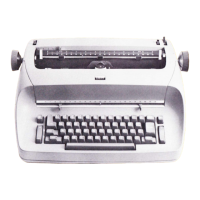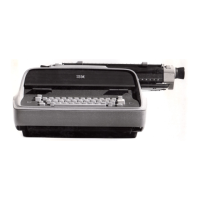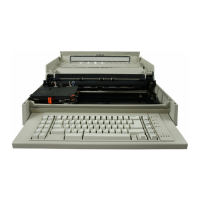INSPECTION
PROCEDURE
Inspection
Period
2
3
4
FIRST
INSPECTION
PERIOD
CYCLE CLUTCH
Inspection Area
Cycle
Clutch
Tilt Mechanism
Ribbon Feed Mechanism
Impression and Alignment
Rotate Mechanism
Detenting
Selection
Magnet Units
Cycle
Clutch
Ilnlatching
Operational
Magnet Units
Pusher Unit
Contact
Cleanin!?
Escapement
Motor Drive and
Carrier
Return
Indexing and Paper Feed
Shift (Enter Mechanism)
1.
Latch height: Measure with #3 scribe
line
on
Hoover-
.ometer.
2.
Cycle
shaft
collar:
The
cycle
clutch
shoul~·begin
to \
slip
approximately 15
0
before the
check
pawl
detents.
Hand
cycle
the
machine,
using a
-5
rotate;
O-tilt
char-
acter.
3.
Nylon stop:
Ad
just for four degrees rotation
or
over-
throw when
the
cycle
shoft
is
latched
home.
4.
Shaft end play:
.001"
-
.003".
5.
All gears: Minimum
play,
no binds, screws
tight.
6.
Print-shaft timing: The keyway should be toward
the
dowel pin on
the
carrier.
TILT
MECHANISM
1.
Check
the
tilt
motion: Use
TO
and T3.
2.
Check
the
tilt
detenting:
Use
a
T3
character
and
hal
f-
cycle
the
machine.
Place
a slight pressure on
the
rear
of
the
tilt
ring.
Remove
the
detent,
and
allow
it
to
re-
turn slowly. The ring should move
~o
more
than
.005".
RIBBON
FEED
MECHANISM
1.
A
-5
rotate,
I-tilt
character
should strike
the
ribbon
1/16"
from
the
bottom in
the
high lift
position.
2.
Check
for enough tension
of
the
ribbon-feed
mechanism-
ratchet-brake
springs
to
hold the ribbon
ratchets
in a
rotated
position,
to
overcome positively
the
action
of
the
centering
spring.
3.
The
ribbon-feed
pawl should hold the reversing
inter-
poser
within
.005"
-
.010"
of
its
total
travel with
the
ribbon-feed
cam on its high point
and
the
ribbon
mech-
anism set for a reversing
operation.
Positive
two-tooth
feed plus
.010"
overthrow should
result.
SECOND INSPECTION
PERIOD
DYNAMIC CHECK
1.
a.
Move the
roller
to
the
top
of
the
compensator.
b.
Repetitively type minus-five
selections.
The
roller
should return
to
rhe compensated
position.
If
wear
has caused the compensator
foller
to drop almost
to
the
bottom
of
the
slot,
hal
f-cycle
a
-5
character.
Ti
It
the
machine up on its
back.
Raise
the
nylon
wedge
manually,
and
tighten
the
rotate
link until
there
is
1/16"
travel
left
in
the
nylon
wedge.
Tighten
the
nuts on
the
rotate
I
ink.
Note:
The
compensator nylon wedge must be
clean
and
free
of
oi
I. I f it does not drop easil y I or
appears
to
be
oily
or
dirty,
flush the wedge with
cleaning
fluid
and
wi pe
dry.
2.
The general
condition
of
all
selection
and
outout-motion
adjustments
can
be
checked
by making a complete
strike-
up
of
the
keyboard.
Type
back
over
it
several times,
watching
for signs
of
misalignment with
the
previously
typed
characters.
If alignment
is
not
satisfactory,
the
need for closer inspection
can
be met by observing
the
dynamic
detenting
action
of
the
typehead.
Manually
half-cycle
the following
selections
one
at
a
time,
and observe
the
latches:
O-rotate,
1
-ti
I t
character
-5
rotate,
l-ti
I t
character
+ 1
rotate,
O-ti I t
character
+2
rotate,
O-til t
character
+3
rotate,
O-tilt
character
These
characters
allow
each
latch
to
be
checked
in-
dividually.
Observe
that
the
selected
latches
clear
the bail
fully,
and
do not snap
off.
Observe
that
the
nonselected,
or
operated,
latch
seats fully on
the
bail,
does not jump
Offi
and makes the
correct
selection.
IMPRESSION AND ALIGNMENT
1.
The
rotate
and
ti
It
tapes must be free
from
kinks
and
nicks.
2.
Check
for binds or excessive
play
in
the
tilt
and rotate
detents with respect
to
their
guides.
Check
the
tilt
ring
in
relation
to
its
pivots,
and
the
upper ball
socket
with
respect
to
the
ti
It-ring
spacer.
3.
Check
for smooth compensator
action.
Static
check:
a.
Half
cycle
a
-5
selection
with
the
typehead
removed.
b.
Pull
the
rotate
arm out until it is
completely
removed
from
the
compensator
leaf
spring.
1-10
c.
Release
the
rotate
arm. This should
cause
the
leaf
spring
to
collapse
against
the
power frame.
ROTATE
MECHANISM
1.
Half-cycle
a
O-rotate,
3-tilt
character
and observe
the
detenting.
Folloy,
the
same procedure for a
+5
rotate,
3-tilt
character
I a
-3
rotate,
3-tilt
character
I
and
a
-5
rotate
I
3-tilt
character.
The
variance
in bandwidth
of
these
characters
should not
exceed
.030".

